







Apollo Galleries presents a finely curated Antiquities collection, featuring a range of Egyptian and Classical art, as well as superb examples from Ancient China and the Near East.
Highlights include an extraordinary Egyptian bronze statuette of the goddess Bastet, a museum exhibited Egyptian stone figure of Osiris, and a rare Gandharan life-size statue of Maitreya.
All of the items listed in this catalogue are available for direct purchase. Please feel free to signal your interest through getting in contact with our Gallery team.
We are based in the heart of Bloomsbury, adjacent to the British Museum. You can book an appointment to meet with our Gallery team or our director Dr. Ivan Bonchev, by contacting us at:
info@apollogalleries.com +44 02072422771
Apollo Galleries, 25 Bury Place, WC1A 2JH Monday – Friday | 9:00 – 17:30
We offer a bespoke Antiquities sourcing service for our clients, working closely with our stock team to match items from across the ancient world with their perfect home.
You can contact us via the email address above to enquire about our services.
We do not charge you for advice and appraisal. Please contact us with images of your collection and we will get back to you within 2-3 business days.
We accept payments in:
US DOLLARS EURO BRITISH POUND
No import taxes for most antiquities when sent to the USA. Packing and shipping is handled in-house by our professional white-glove team.




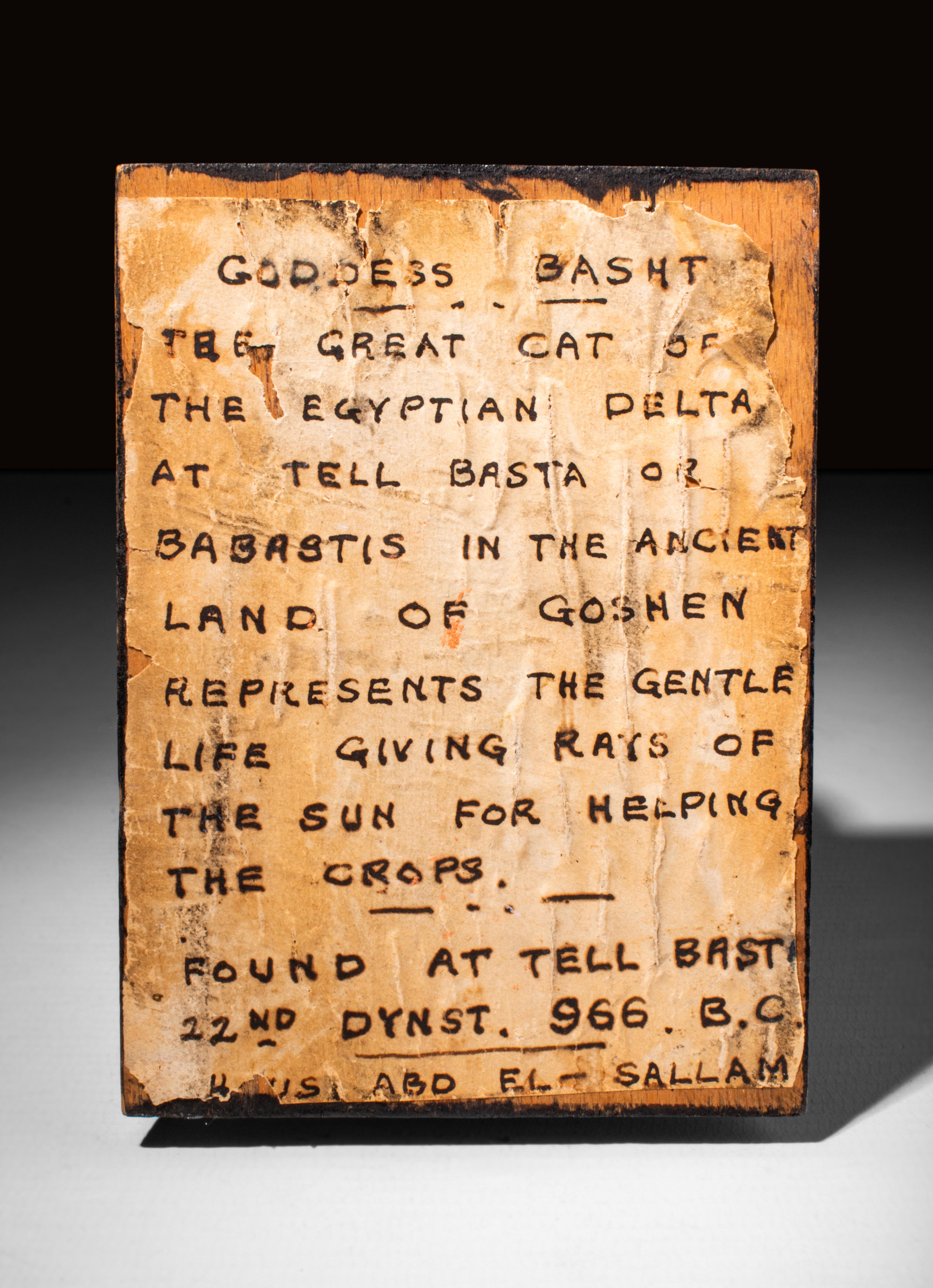
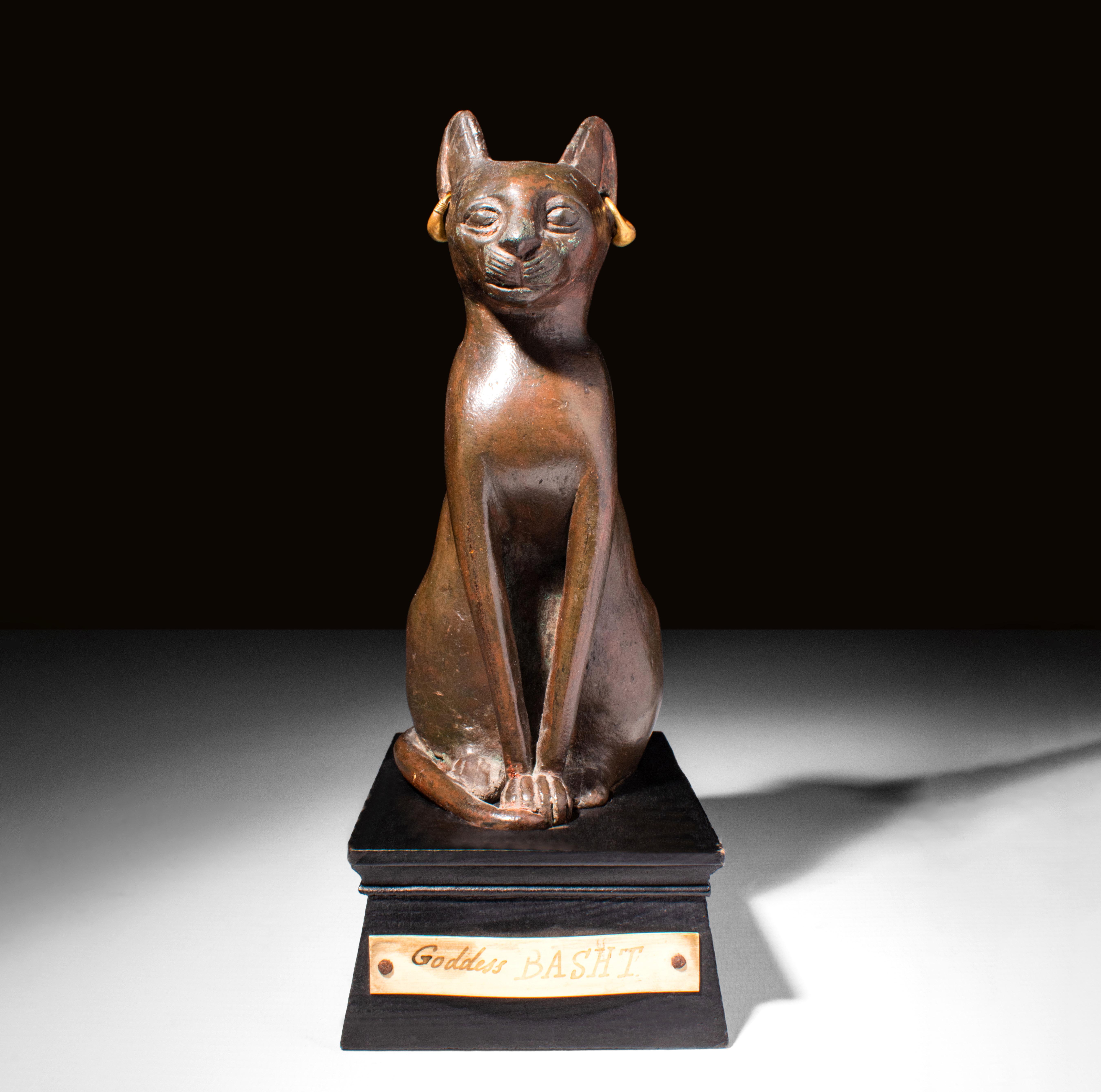
Late Period, XXVI Dynasty, Ca. 664-525 BC
£35,000
A hollow cast and finely proportioned bronze cat. The animal is depicted naturalistically, seated with its forepaws together and its tail curving forward around the proper right side. The erect ears bear incised tufts on the interior and are pierced with gold earrings. The large convex eyes have contoured lids and defined irises. The item is accompanied by a historical report from Simone Musso, consultant curator for the Egyptian antiquities at the Stibbert Museum, Florence, Italy; member of the Nuri Archaeological Expedition. For similar see: Christie’s, Live Auction 3748, Antiquities, Lot. 14. Size: 210mm x 110mm; Weight: 735g.
Provenance: Private UK collection, M.H., acquired in early 2000s; previously, in a UK London collection formed in the 1960s.

Third Intermediate Period, XXI-XXII Dynasty, Ca. 1085-713 BC
£10,000
A large Egyptian faience amulet of Sekhmet, the lion-headed goddess of the sun, destruction, war and healing. The deity is shown seated on a throne realised in openwork technique. The snake-headed god Nehebkau is depicted to the sides, whilst a djed pillar is carved at the back of the royal seat; an integral suspension loop features behind the goddess’ head. Sekhmet herself wears a tripartite wig, a long gown, and holds a sistrum, a percussion instrument used in religious ceremonies. Her feline face is rendered with recessed eyes, furrowed brows, tapered snout and a short mane. Two very minor glaze flakes on the corners of the integral slab base, otherwise an exceptional quality example. Custom black lucite tiered base. Size: 15mm x 66mm x 97mm.
Provenance: Private London collection; formerly, ex. Ariadne Gallery, NYC. Previously, in a private Connecticut, USA collection; ex-private collection, Pennsylvania, USA. Ex-European private collection, acquired in Brussels in the early 1970s. Art Loss Report S00098626.

Pre- to Early Dynastic Period, Ca. 3000-2200 BC
£8,000
A large Predynastic black-topped jar featuring a tall, bulging body which narrows towards the flat base. The inverted rim displays the distinctive black finishing of the period. Reassembled from approximately four large original pieces, restoration over the breaks. Custom base.
The characteristic black-red colours of Predynastic black-topped pottery were achieved by manipulating the firing conditions. Iron-rich clay was oxidised to produce a bright red base, which was later placed in sawdust or ash to cut off the oxygen supply and obtain the black finishing around the rim. For similar see: The Metropolitan Museum, accession number: 36.1.4. Size: 320mm x 170mm; Weight: 2.44kg.
Provenance: Private London collection; formerly, in a private NYC collection. Ex. Edward H. Merrin Gallery, NYC. 1970’s or 1980’s.


Late Period, Ca. 664-332 BC
£20,000
An Ancient Egyptian stone statuette depicting the god Osiris, shown seated in mummiform with a braided divine beard, an atef-crown, and a peaceful, idealised face. He is posed with the arms folded across the chest holding a crook and flail. Osiris is the most significant and important god in the Egyptian pantheon. He was known firstly as a god of fertility, then as a god of the underworld. In his role of Lord of the Underworld, he was associated with the pharaohs and is, thus, generally portrayed as a deceased pharaoh, as seen on this figure. This very important example was exhibited at Kresge Art Gallery, Michigan State University, 1985 to 2002. Published: J. Eisenberg, Art of the Ancient World, vol XXII (2011), no.158. Size: 145mm x 75mm; Weight: 580g.
Provenance: Property of a Central London Gallery, acquired by a British collector, ex-private Bandy collection, Rochester, Michigan, USA; ex. Royal Athena Gallery, 1986. Exhibited: Kresge Art Gallery, Michigan State University. Olympia Art & Antiques fair, London June 2022.
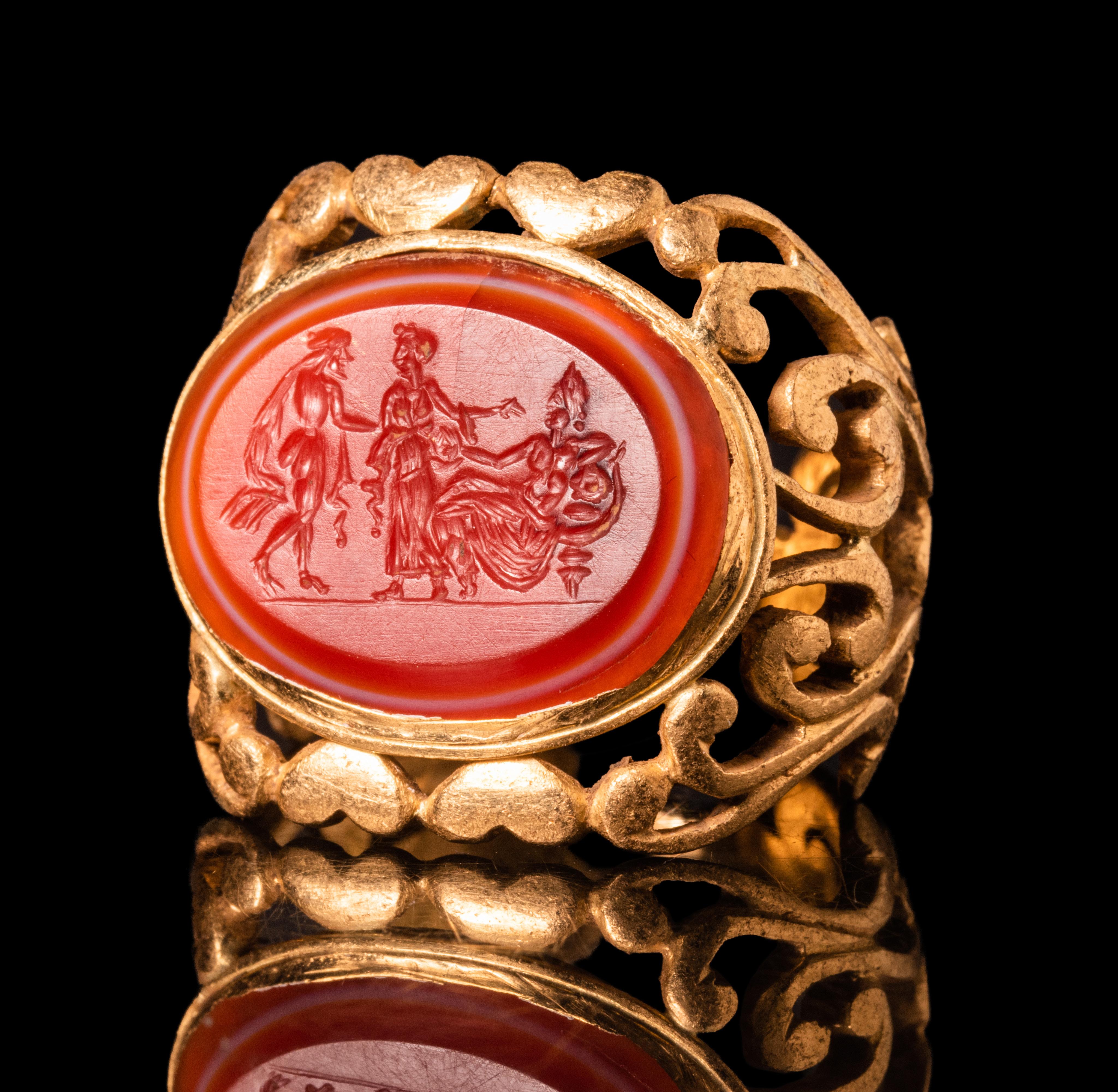
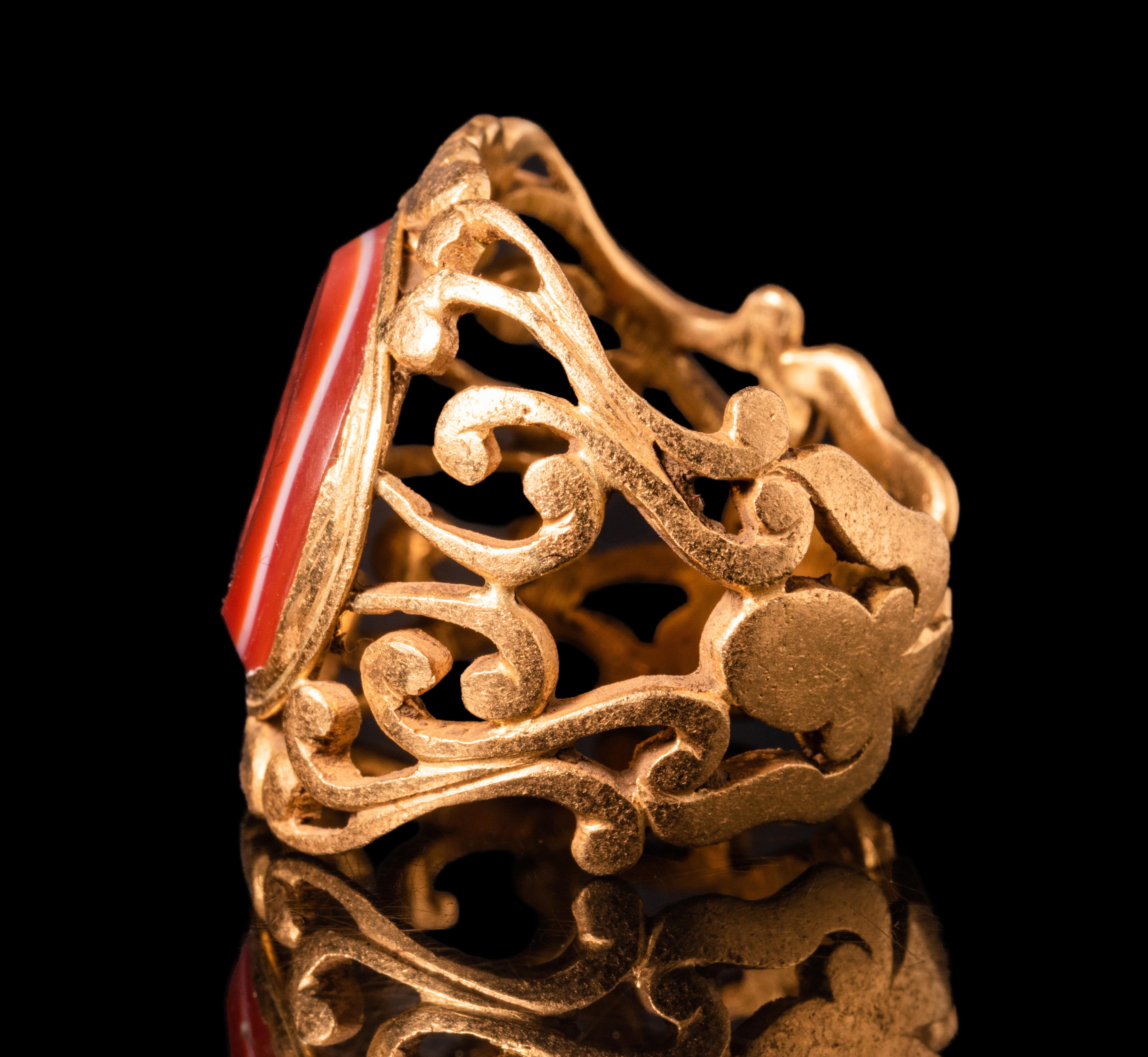
ROMAN HEAVY OPENWORK
GOLD RING WITH AGATE INTAGLIO
Ca. 2nd-3rd Century AD
£12,000
A solid gold ring set with a large agate intaglio depicting a banquet scene. To the right, a crowned woman lays comfortably on a kline, while extending a had towards two standing figures engaged in a conversation. The circular hoop is rendered with an intricate openwork technique in the form of floral motifs.
Size: D: 20mm / UK: R 1/2; Weight: 16.63g.
Provenance: Private London collection; formerly, ex. Parthenon gallery, acquired in the 1990s.


ROMAN HEAVY GOLD RING WITH CARNELIAN INTAGLIO OF A YOUTH
Ca. 1st-2nd Century AD
£10,000
A substantial solid gold ring with a circular hoop and expanding shoulders; a large carnelian rests within the raised bezel. The stone is finely engraved with the depiction of a partially nude youth, seen leaning onto a pillar as he lifts his robes with his left hand. The soft cap on his head places the image close to the iconographic scheme of the god Attis. Size: D: 25mm / UK: Q 1/2; Weight: 19.04g.
Provenance: Private London collection; formerly, ex. Parthenon gallery, acquired in the 1990s.

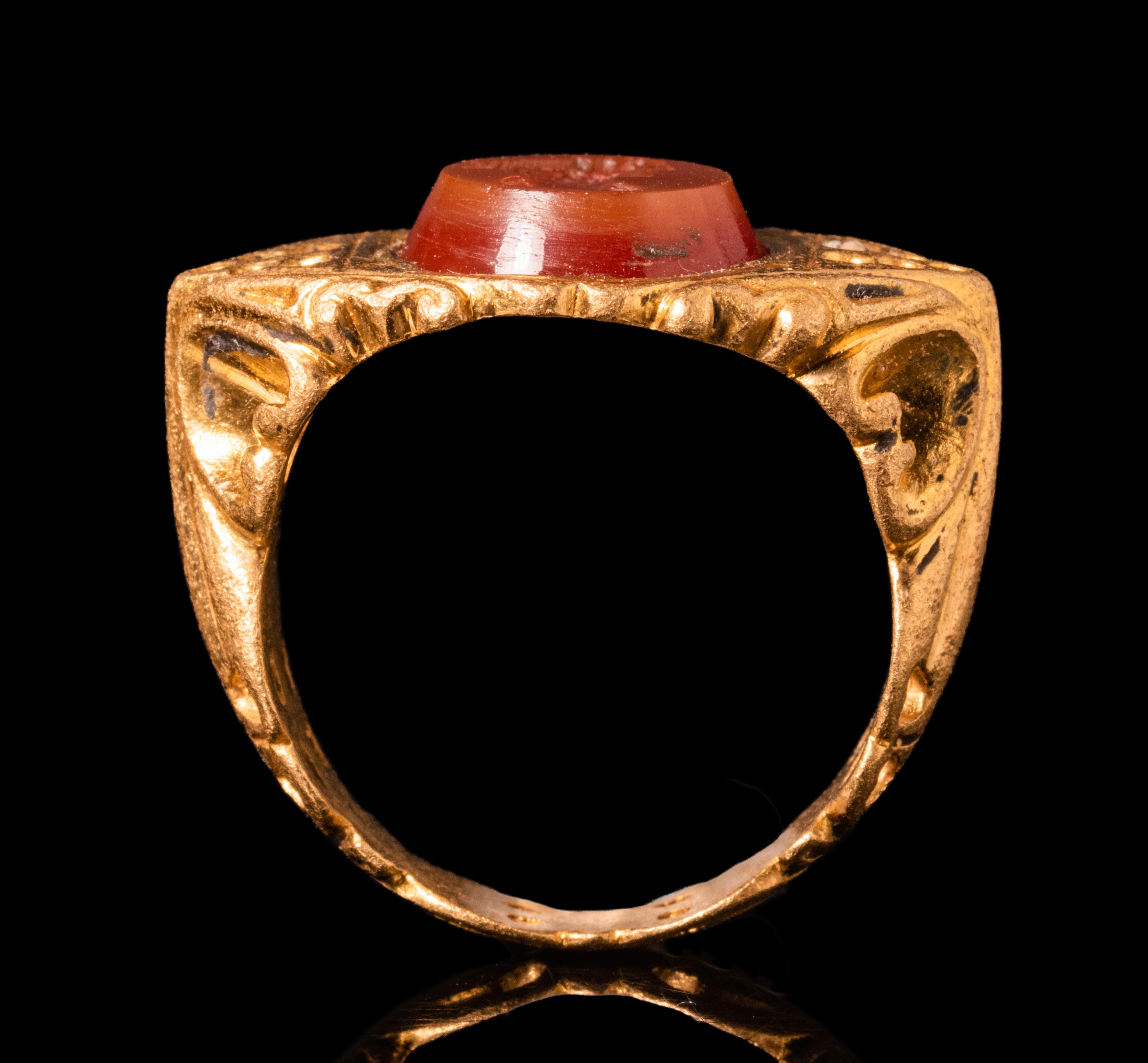
ROMAN GOLD RING WITH CARNELIAN PORTRAIT INTAGLIO
Ca. 2nd-4th Century AD
£7,500
A Roman gold ring with with a carnelian female portrait intaglio. The ring is comprised of a massive hoop with strongly projecting shoulders and an eye shaped bezel. The entire ring is decorated with elaborately incised patterns and openwork, with beautiful open heart-shaped details symmetrically placed at the top of the shoulder. The ring is inset with a raised, oval-shaped and flat carnelian stone with a right-facing female portrait. Size: D: 21mm / UK: U; Weight: 18.56g.
Provenance: Private London collection; formerly, ex. Swiss collection, Geneva, formed in the 1990s.


Ca. 2nd-4th Century AD
£6,500
A Roman gold chain finely made with intertwining gold hoops. It features finely crafted finials original to the piece composed of conical-shaped tubes on the ends, designed for a secure closure. Size: 485mm; Weight: 32.08g.
Provenance: Property of a London gallery; previously in a collection of a North London gentleman; formerly, in a collection of Mrs B. Ellison, a deceased former member of the Egyptian Exploration Fund, bought from the 1940s, Cairo and London.

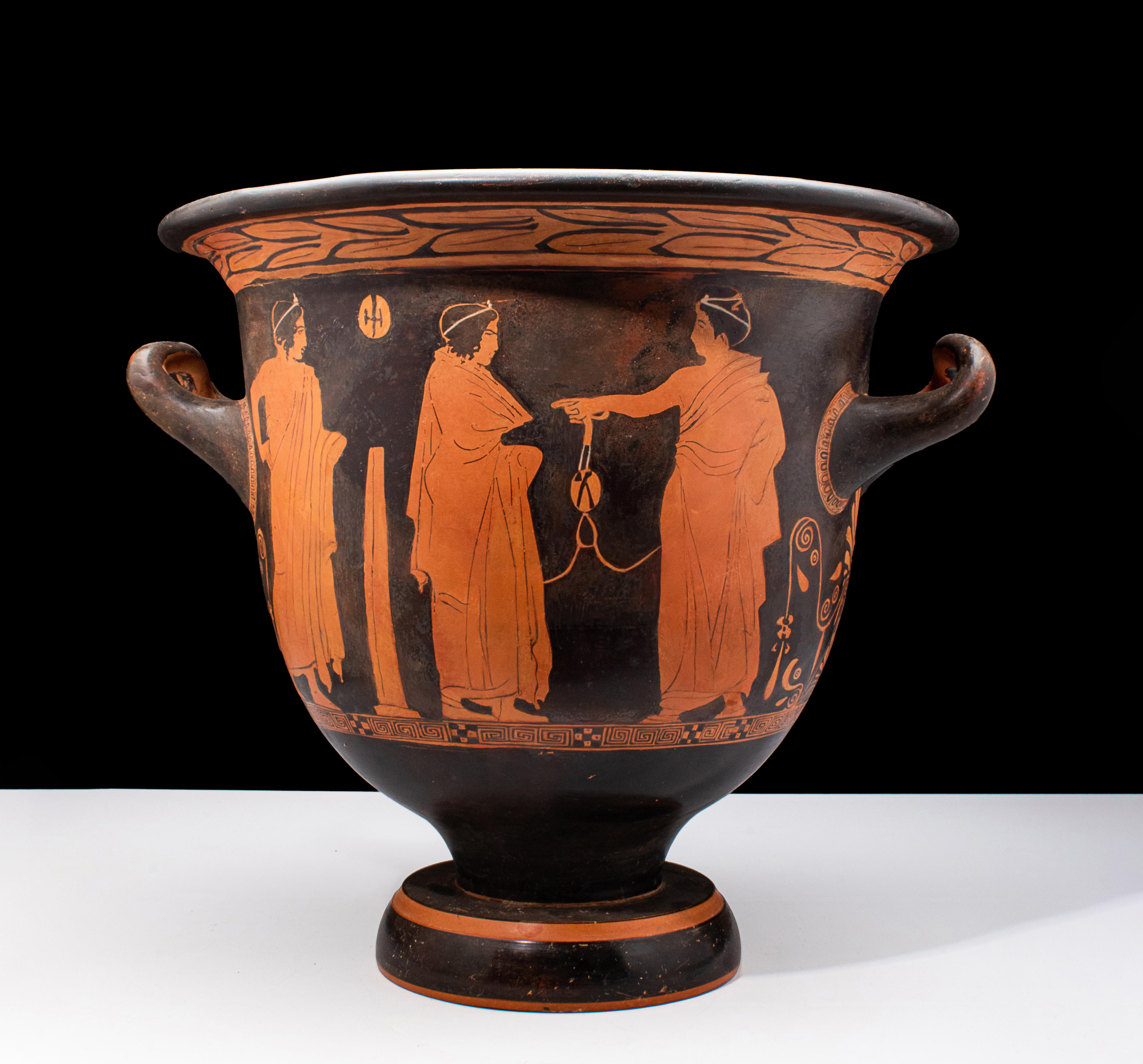
Ca. 420-380 BC
£25,000
An Attic red-figure bell krater. On side A, the obverse depicts Ganymede in the Garden of Zeus. The youthful hero stands in his distinctive pose, holding a white rooster in front of a seated Zeus. Both figures are crowned with olive leaves and fruits. Beside Ganymede stands a winged Eros with his left leg bent at the knee. Behind the hero, two goddesses, likely Athena and Artemis, are depicted within clouds. On the left side of the scene, Hera is shown with a scepter; her head turned towards her husband Zeus and Ganymede. On side B, two figures are depicted wearing Tainia headbands. They are seen engaging in dialogue within a Palaestra scene. Behind the left figure there is an altar; weights hang from the wall in the upper part. Palmette motifs are particularly noticeable under the handles. A laurel wreath is under the rim.
The Tainia headband was a component of traditional ancient Greek attires, often worn during Greek festivals. The gods themselves were depicted wearing Tainia headbands, and they were also used in religious contexts, such as adorning cult images, trees, urns, monuments, animal sacrifices, and the deceased. The Romans later adopted similar headbands. Another type of headband, the diadem, was commonly used as a symbol of royalty.
Size: 380mm x 430mm; Weight: 5.13kg.
Provenance: Private London collection; formerly, private German collection, formed in the 1980s.



Ca. 325-300 BC
£12,000
An Apulian red-figure patera painted in black and enriched with white and yellow details. The vessel is characterised by a tall bell-shaped foot, a wide body and a rim decorated with relief dots and leaf-shaped handles. The internal decoration shows a central medallion framed by a continuous ivy vine. This presents a single register depiction, in which two figures stand facing each other. On the right is a woman wearing a tunic, an elegant Sakkos and jewellery. She holds two paterae, one of which filled with offerings. On the left is a boy seen wearing a laurel wreath and holding a sack and a spear.
The scene can probably be interpreted as a soldier leaving for war. The warrior begins his journey without his shield (on the right of the woman), indicating that he will not return, while his wife brings him funeral offerings to indicate his fate. The scene takes place in a garden designed in a very naturalistic manner. The outer side of the vessel is adorned with red-figure scenes of offerers and winged erotes bearing gifts, alternating with highly articulated palmette motifs. Size: 445mm x 430mm; Weight: 2.61kg.
Provenance: Private London collection; formerly, in a private German family collection, acquired in the mid-1960s.


Ca. 420-380 BC
£20,000
A late Attic bell-shaped krater featuring two main decorations. On side A, two soldiers are depicted in heroic nudity, facing each other while holding spears. Their bodies are depicted in an extremely schematic manner, with the torso’s muscles represented frontally. To the left, a tall Nike is seen holding a patera as an offering. On side B, three figures wearing cloaks are depicted, maintaining the pattern of one figure on one side and two on the other. The drapery is represented with simple vertical black lines without three-dimensionality. A stylised laurel wreath is under the rim. Size: 370mm x 420mm; Weight: 5.78kg.
Provenance: Private London collection; formerly, ex. Harlan Berk Gallery, Chicago, IL.


BYZANTINE GOLD NECKLACE WITH CROSS PENDANT
Ca. 6th-7th Century AD
£8,000
A Byzantine gold necklace made with flawless round links, interspersed with multicoloured precious stones. At the centre, the necklace lowers into a refined Latin cross pendant featuring a large garnet cabochon. The pendant is further enriched with clear, pale-blue stones and small pearl finials.
Crosses used as personal adornments appeared by the 5th Century AD. Polychrome jewellery, such as this exquisite example, was particularly prized in the early Byzantine world. For a similar see: The Metropolitan Museum, accession number: 17.190.1660. Size: 347mm x 29mm; Weight: 34.06g.
Provenance: Private London collection, formed on the UK/international art market in the 1990s.

BYZANTINE GOLD CROSS WITH GARNET, PEARLS AND GLASS BEADS
Ca. 5th-6th Century AD
£3,500
A Byzantine gold cruciform pendant with hollow, conical arms, each capped with a dome centred by a gold granule. A circular bezel set with a garnet cabochon adorns the pendant at the centre. Two green glass paste beads dangle from the arm. The piece is further enriched by additional glass beads and pearls. For similar see: Christie’s Live Auction 2271, Ancient Jewelry, Lot 337. Size: 44mm x 32mm; Weight: 5.75g.
Provenance: Private London collection, formed on the UK/international art market in the 1990s.



BYZANTINE GOLD RING WITH GARNET AND PEARLS
Ca. 4th-5th Century AD
£8,000
A substantial Byzantine gold ring featuring a round-sectioned hoop and a rectangular bezel set with a deep red garnet. The stone presents an unusual cutting, with clean geometrical faceting typical of 14th Century Venetian style. Two long horns with pearls extend from the shoulders, both original to the piece. Gold scrolls with gold granules further decorate the sides. Overall a very remarkable example. Size: D: 17.4mm / UK: O ½; Weight: 11.77g.
Provenance: Private London collection; formerly, ex. Parthenon gallery, acquired in the 1990s.


INDUS VALLEY TERRACOTTA VESSEL WITH ANIMALS
Ca. 3000-2500 BC
£12,000
A large Indus Valley painted terracotta vessel with a bulbous body rising from an undecorated conical-shaped base. The exterior decoration consists of three registers of polychrome parading animals: lions, zebu bulls with birds, and fish, separated from each other by decorative bands. From the main body, a wide and tubular neck protrudes, which is decorated with geometric patterns. Item comes with a professional historical report from Ancient Report Specialists. Size: 600mm x 430mm; Weight: 12.95kg.
Provenance: From the private collection of Mr. R. Unger; previously with a London gallery; acquired in the 1980s on the UK art market.
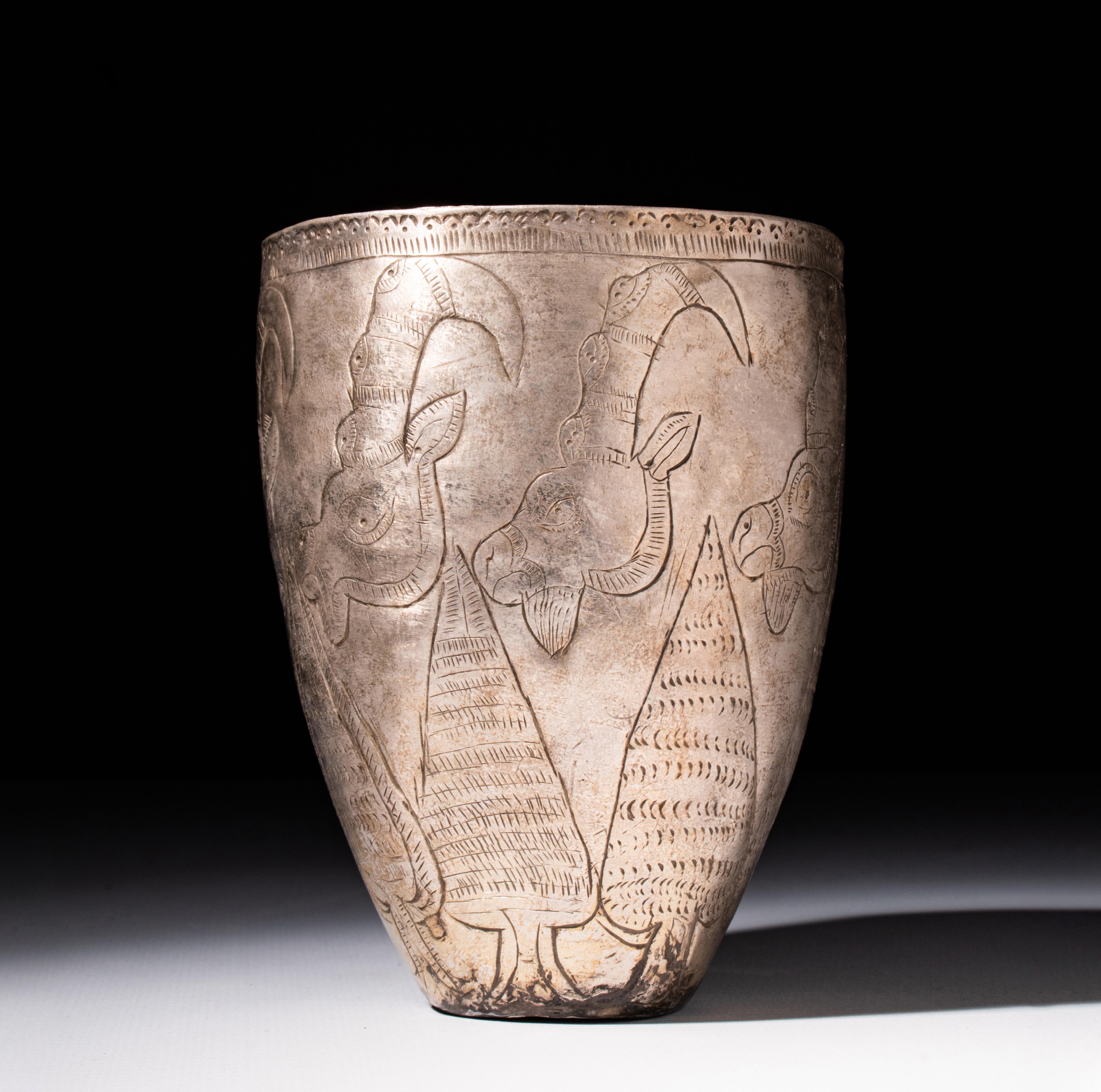
Ca. 2700-1500 BC
£9,000
A well-formed silver Elamite beaker with intricate incised decoration. The vessel features a frieze of stylised rams or ibexes on its exterior, a distinctive Iranian motif suggested to be associated with heroic rulers or protective spirits. Below them is a frieze of stylised trees, also known as tree of life.
Representations of animals comprised a large portion of the ancient artistic repertoire. Specifically, images of wild animals with features considered dangerous or powerful appear in all periods of ancient Near Eastern art, dating back to the Neolithic period. The tree of life motif was first developed in Mesopotamia during the 4th millennium BC, and was found everywhere within the Near Eastern oikumene by the 2nd Millennium BC, and later embraced within Christian iconography. Size: 115mm x 90mm; Weight: 150g.
Provenance: Private London collection, H.A., formed in the 1970s.


Ca. 1900 BC
£15,000
A complete Old Babylonian terracotta tablet presenting the characteristic pillow-shaped form. The tablet is inscribed on both the obverse, sides, and reverse with cuneiform script neatly organised into vertical columns. The tablet displays the cuneiform sign ‘ki’ or ‘e2’, indicative of a place or house respectively.
Cuneiform script is one of the oldest types of writing, originated in the Middle East around 3500 BC. The name comes from the shape of the marks imprinted on small clay tablets with a piece of a wedge-tipped reed. Its creation was related to the administrative and economic needs of the developing civilisation. For similar see: The British Museum, accession number: 1897,0510.3. Size: 169mm x 125mm x 31mm; 1.02kg.
Provenance: Private London collection, H.G.; formerly acquired in the early 2000s in Belgium; previously, in a 1970s European collection.
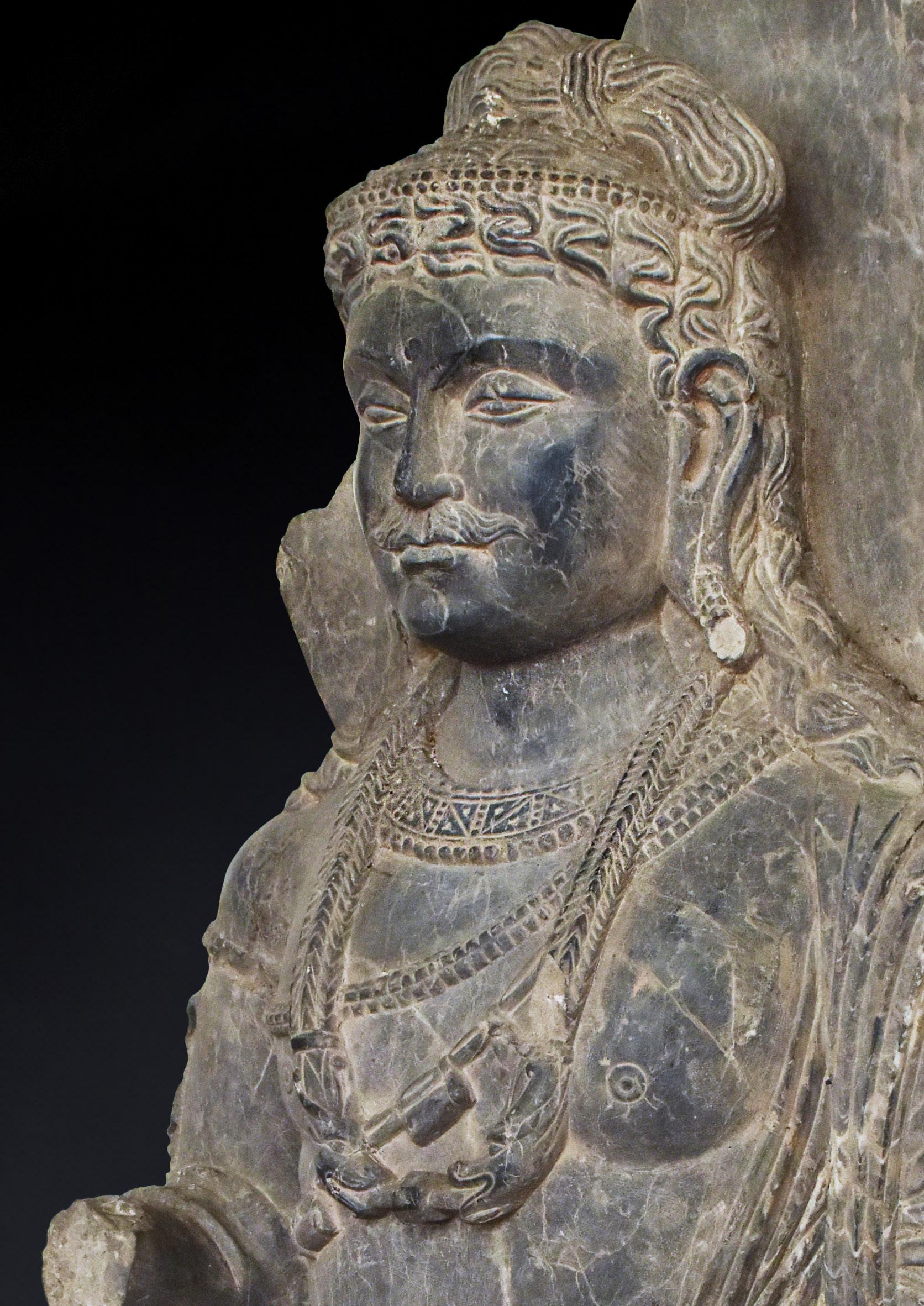

Ca. AD 200-300
£25,000
A large and important grey schist carved torso of Maitreya depicted surrounded by a halo and wearing a dhoti in gracefully draped thin pleats. A shawl, similarly folded, elegantly hangs around his left arm. The muscular torso is adorned with elaborately crafted, beaded necklaces and amulets. He has deep carved eyes, a pronounced brow, a moustache and a urna on the forehead. For similar see: The Los Angeles County Museum of Art (LACMA) M.83.105.1. Item comes with a professional historical report from Ancient Report Specialists. Size: 1060mm x 560mm; Weight: 50kg+.
Provenance: Property of a West London gentleman; previously, in a private London collection formed on the UK/International art market in the 1990s. This item has been checked against the Art Loss Register database.

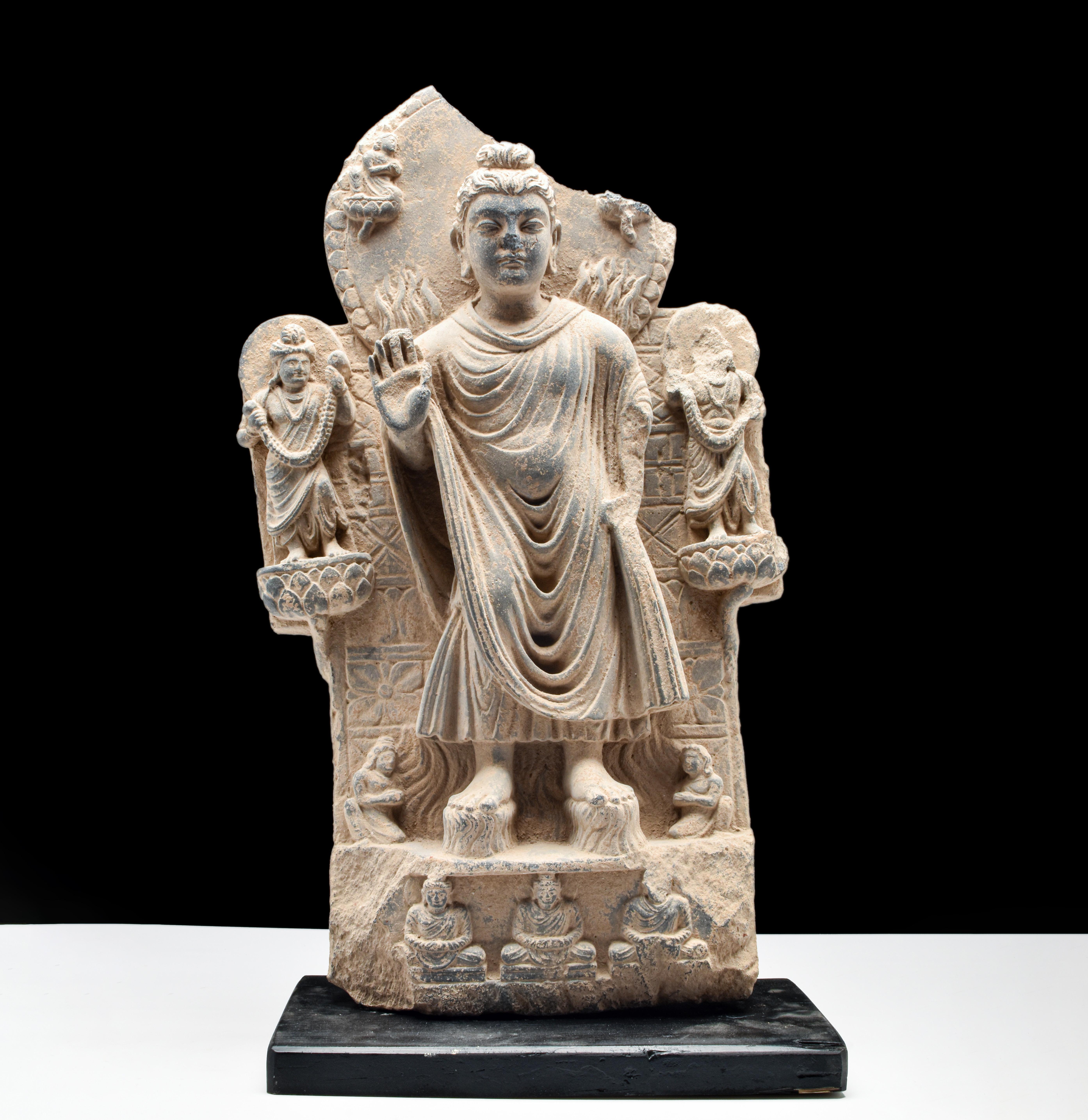
Ca. AD 200-300
£5,000
A schist stone carving of the standing Buddha performing Twin Miracles. The deity’s head is backed by a halo with the flames miraculously lit from his shoulders and water emerging from his feet. The head is exquisitely carved with naturalistic features, including deep-cast, almond-shaped eyes, arched eyebrows, smiling lips, and elongated earlobes. The figure wears a full-length sanghati robe nicely accentuated with detailed drapery, giving a sense of movement and dynamism. The Buddha stands atop a plinth decorated with a relief scene of three meditating figures, and he is flanked by votives and bodhisattvas. Mounted on a custom-made stand.
The Miracle of Sravasti is a significant episode in the life of the Gautama Buddha, highlighting his extraordinary spiritual powers and prowess. The narrative unfolds during a so-called “miracle contest” where Gautama Buddha engages in a display of supernatural abilities to establish the superiority of his teachings over those of six rival religious teachers. Size: 620mm x 330mm; Weight: 30kg+.
Provenance: From the collection of a London gentleman; formerly, acquired on the Belgium art market in the 1960s.

CHINESE TANG DYNASTY TERRACOTTA FAT LADY - TL TESTED
Ca. AD 618-907
£6,500
A Chinese terracotta statue of a ‘Fat Lady.’ Crafted with meticulous attention to detail, the statue stands with a graceful pose, resting upon an integral flat base. She wears a long, flowing robe that drapes softly around her form; one of her small hands, raised in a poised gesture, remains uncovered. Her face, delicately painted, features rouged cheeks that enhance her complexion, while her black eyebrows add definition to her expression. A lavish coiffure frames her face, meticulously arranged to accentuate her beauty. Traces of coloured pigment on the robe, face, and hair.
The popularity of the ‘Fat Lady’ figurines reflects a broader cultural shift in the perception of feminine beauty during the Tang Dynasty. These figurines became visual manifestations of this evolving beauty standard, embodying the grace and allure of women with more generous proportions. This piece has been precisely dated having undergone Thermo Luminescence analysis by Ralf Kotalla. For similar see: Christie’s, Live Auction 2830, Fine Chinese Ceramics and Works of Art, Lot 2070. Size: 630mm x 260mm; Weight: 9.40kg.
Provenance: East Anglian private collection; formerly, acquired in the early 1990s in Hong Kong.

Ca. 202 BC - AD 220
£6,000
A Chinese pottery model of a seated dog in a forward-facing position. The animal is portrayed with an alert expression captured through the raised head and pricked-up ears. The dog is adorned with an elaborate harness and a collar, further accentuating the attention to detail in its creation.
During the Han Dynasty, dog figures like this one held significant cultural and symbolic meanings. These pottery models were primarily created for funerary purposes, intended to serve as guardians and protectors in the afterlife. They were commonly placed in tombs as part of the burial rites, accompanying the deceased on their journey to the next world. The inclusion of these guard dog figures in Han Dynasty funerary practices reflects the cultural beliefs and spiritual traditions of the time. This piece has been precisely dated having undergone Thermo Luminescence analysis by Ralf Kotalla. For similar see: The Indianapolis Museum of Art, accession number 1999.2A-B.
Size: 520mm x 185mm; Weight: 7.30kg.
Provenance: East Anglian private collection; formerly, acquired in the early 1990s in Hong Kong.


CHINESE TANG DYNASTY TERRACOTTA HORSE - TL TESTED
Ca. AD 618-907
£8,500
A large hollow-moulded terracotta horse crafted in a standing pose on an integral flat base. The horse exhibits a lowered head turned to the side, with pricked-forward ears. Its well-defined head features bulging eyes, pronounced nostrils, a neatly arranged forelock, and a short mane; the tail is depicted as docked and bound. The long legs culminate in naturalistically rendered hooves, and the body is adorned with still-vibrant red pigment. Additionally, the horse bears a lightly painted peach saddle with a dotted saddle cloth on its back. This piece has been precisely dated by means of a Thermo Luminescence analysis carried out by Ralf Kotalla. For similar see: The Metropolitan Museum, accession number: 25.20.4. Size: 685mm x 680mm; Weight: 19.74kg.
Provenance: East Anglian private collection; formerly, acquired in the early 1990s in Hong Kong.

The Late Period is a long, tumultuous, and fascinating time in Egyptian history. Characterised by an alternation between periods of native rule and foreign domination, the Egyptians during this time were connected to and ruled by many cultures across the ancient world, including the Assyrians, Persians, Phoenicians, and the Greeks. [1] Despite the frequent chaos, Egyptian arts and culture persisted steadfastly and thus through looking at the star of this catalogue, The Egyptian Bronze Cat With Gold Earrings, we can get a sense of the changing artistic trends and socio-political concerns of the time.
The beginning of the Late Period is traditionally set at 664 BC, when the Assyrians finally withdrew from Egypt and left it to Psamtek I, the first of the Saite Kings (Hdt.II.152-3). [2] Named by Manetho for their origin in Sais, the 26th Dynasty of Egypt ruled prosperously for 130 years, reviving Egypt from a vassal state of Assyria into an ally and independent kingdom. [3] The 26th Dynasty utilised mercenaries from across the Greek world in their military campaigns, installing various Carians, Greeks, and Phoenicians in their own quarters in the city of Memphis and allowing the establishment of the Greek trading settlement of Naucratis in the 7th Century (Hdt. II.28). [4]
The Persians conquered and overtook Egypt from the Saite kings in 525 BC, ruling the territory as a satrapy until 404 BC, when a coalition of Egyptian kings succeeded in overthrowing their masters. [5] Dynasties 28 to 30 continued Egyptian rule untwil 343 BC, when the Persians re-established their control over the region before being destroyed by Alexander III of Macedon. Before this, the 30th Dynasty undertook an ambitious artistic and cultural program, constructing many major temples. [6]
The reestablishment of strong Egyptian kingship under the 26th Dynasty, combined with the nexus of cultural influences filtering into Egypt at the time, created a fruitful and rich artistic landscape. Following the 25th Dynasties’ (739–656 BC) preference for hardstone statuary, sculpture became the dominant art form in Egypt, with relief sculpture and architecture close behind. [7] This period is known especially for its archaising, classicising compositions. These hark back to the sculptural proportions of the Old Kingdom, with its thickly muscled, broad-shouldered figures. These models were perhaps used to mark the 26th Dynasty as the inheritors of a long, Egyptian tradition following a period of foreign rule. [8] The 30th Dynasty similarly looked backwards from the period of Persian domination to the art forms of the 26th Dynasty, instigating another iteration of this tradition.
In terms of style, the art of the Late Period moves towards the naturalistic. This cannot be called portraiture, but the treatment of the human face of non-royal persons during the 26th Dynasty demonstrates a desire to include individualised features rather than idealising representations. [9] This trend was also present in animal sculpture, as creatures begin to be rendered with remarkable attention to the modelling of bones, muscles, and proportions. [10]
A major development in the religious life of the Late Period was the widespread popularity of cults with animals as their image, a trend that only accelerated in the Ptolemaic period. This significant change was partially based on the wide-ranging reforms under the native Egyptian dynasties that encouraged the growth of the sacred animal industry. These reforms allowed the state could generate revenue from taxes on these cults and the sale of religious offices. [11]
 Fig. 2: Tall Egyptian Faience Statuette of The Goddess Sekhmet
Fig. 2: Tall Egyptian Faience Statuette of The Goddess Sekhmet

Known as miw in the Egyptian language, cats were deeply embedded into the fabric of Ancient Egyptian life. [12] This stunning bronze piece therefore provides an excellent springboard to consider how cats came to be worshipped in Egypt and emblematic of the goddess Bastet. Cats, unlike many other animals native to Egypt, were not associated with a specific god in early Egyptian religion, but rather generally respected in the world of personal religion for their apotropaic, protective qualities. [13] Our first recorded instance of cats being written into religion comes in Ca. 2100 BC, when they are connected to the sun god Ra in the Coffin Texts. [14] During the New Kingdom cat-headed deities and demons appear in the religious corpus, with even Ra being named the “Great Tomcat” in the Library of the Sun, and by the 1st millennium BC cats were regarded as divine manifestations of many deities, being bred in both temple catteries and across Egypt for their time-honoured protective properties. [15]
One such deity associated with the cat is Bastet, the chief deity of the city of Bubastis. Daughter of the sun-god Ra and linked also to the cities of Heliopolis and Memphis, Bastet formed the protective, nurturing counterpart to the warlike goddess Sekhmet from ca. 1850 BC. Our first visual evidence of the goddess comes from stone vessels from Saqqara ca. 2800 BC. However, these vessels depict Bastet with a lion head and with a uraeus on her forehead, holding an ankh and sceptre. It is only during the 22nd Dynasty (946–715 BC) that Bastet becomes associated with the cat. [16]
This may have been due to the period of prosperity occurring in Bubastis, as the city became an administrative centre under the 22nd Dynasty, possibly due to the ruling families’ origins in the region. This political change coincided with the aforementioned popularity of the festival of Bubastis and building of numerous temples for Bastet during the reigns of Oshorkon I and II. The change also aligns in religious terms, mirroring the goddesses’ conflation with Sekhmet using the similar yet more protective and nurturing cat to contrast with the more aggressive lion.
The increased popularity of Bastet continued into the Late Period, leading to the production of many bronze cat statuettes, such as our high-quality example. The larger examples were hollow cast, while some smaller cats were solid cast. Some were intended for a funerary purpose, storing cat remains within their hollow bodies, while others bore suspension loops and were thus attached to garments or used as personal talismans. Most were probably made for dedication at a shrine. These dedications could express gratitude to Bastet, elicit further favour from the goddess, or perhaps commemorate a pilgrimage to Bubastis and her shrines. They were likely bought from a local temple, dedicated at the shrine, and then placed in a ritually dwug pit along with other small offerings once the temple became too crowded.[18]
Bronze cat statuettes begin to be produced around ca. 900 BC, with the most being cast during the Ptolemaic period. Examples dating to the 26th Dynasty, as ours is, are therefore quite rare. [19] Composition varies considerably, but our cat is constructed in the characteristic ‘hieroglyphic’ position, seated with the tail on the ground and paws close together. Other common positioning includes standing, sleeping, walking or crouching. The positioning of the tail to the right aligns with the right-facing conventions of two-dimensional Egyptian art. [20]
The naturalistic style of the cat fits well into the artistic concerns of the 26th Dynasty, boasting an extreme attention to anatomical detail without sacrificing any of the regal frontality of the creature. Precious metals fixtures such as gold earrings feature on the designs of particularly high-quality cast examples. Some examples also bear nose rings, the sun-disk / uraeus of Bastet, or even a necklace of pendants or cowrie shells. [21] It may have been the case that some cats could have been adorned with rings in real life, but the inclusion of such valuable details may instead reflect their divine status as representations of Bastet.
The bronze cat statuette is therefore emblematic of the artistic and religious concerns of the Late Period, particularly that of the 26th Dynasty. It reflects the growing popularity of Bastet and Bubastis as a cult centre, as part of a wider trend towards the worship deities in the guise of animals. The beautiful and naturalistic construction also emblematises the individualised nature of Late Period art, no doubt drawing from the wealth of cultural influences permeating Egypt at the time. In a narrower sense, this statuette forms almost the culmination of centuries of Egyptian thinking on the cat, as it moved from an auxiliary figure grounded in domestic religion, to an essential part of every household, to a revered vessel of the mighty Bastet.

Allen, J., & Hill, M., 2018, “Egypt in the Late Period (ca. 664–332 B.C.).” In Heilbrunn Timeline of Art History. New York.
Bothmer, B. V., 1960, Egyptian Sculpture of the late period, 700 B.C. to A.D. 100. New York.
Bresciani, E., 2002, “The Late Period”. In Zeigler, C. (Ed.), The Pharaohs. New York.
Challis, D., 2015, “Miw: the Langton Cat Collection.” In Stevenson, A. (Ed.), Petrie Museum of Egyptian Archaeology: Characters and Collections (1st ed) 72-73.
Málek, J., 1993, The Cat in Ancient Egypt. London.
Robins, G., 2002, The Art of Ancient Egypt. London.
[1] Bothmer 1960, xxxii.
[2] Allen and Hill 2018.
[3] Bresciani 2002, 85; Allen and Hill 2018.
[4] Bresciani 2002, 85; Allen and Hill 2018.
[5] Allen and Hill 2018.
[6] Allen and Hill 2018.
[7] Bothmer 1960, xxxiii.
[8] Bothmer 1960, xxxvii; Robins 2008, 210.
[9] Bothmer 1960, xxxviii.
[10] Allen and Hill, 2018.
[11] Málek 1993, 98.
[12] Challis 2015, 72.
[13] Málek 1993, 73.
[14] Málek 1993, 77-9.
[15] Málek 1993, 81; Challis 2015, 73.
[16] Málek 1993, 95.
[17] Málek 1993, 94.
[18] Málek 1993, 100, 107.
[19] Málek 1993, 101.
[20] Málek 1993, 101-5.
[21] Málek 1993, 102.
We pride ourselves on providing excellent customer care to all of our clients. If you have any inquiries regarding the items, our team will be happy to guide you through every step of the way. We strive to ensure that every customer has a smooth and enjoyable experience. In addition, we value feedback from our customers and are always looking for ways to improve our services. If you have any suggestions or comments, please do not hesitate to let us know.
At our gallery, we take privacy and safety very seriously. We understand the importance of protecting our clients’ personal and financial information, as well as ensuring that all transactions are secure and confidential. We have implemented industry-leading security measures to safeguard your data and prevent unauthorised access. Our website is encrypted with advanced SSL technology, which ensures that all sensitive information is transmitted securely over the internet. In addition, we adhere to strict privacy policies and will never share your information with any third parties without your consent. We also require all of our employees to adhere to strict confidentiality agreements to protect your information. When it comes to the physical safety of our clients, we maintain a secure and controlled environment at our gallery. Our premises are equipped with surveillance cameras to ensure the safety of our clients and their property.
We understand that privacy and safety are of utmost importance to our clients, and we are committed to providing a secure and trustworthy experience. If you have any questions or concerns about our privacy and safety policies, please do not hesitate to contact us.
We want you to be completely satisfied with your purchase, and we understand that there may be circumstances where you need to return an item.
If you receive an item that is not as described, you may return it to us for a refund. However, please note that we only accept returns if there is substantial proof provided by a certified expert that the item is not as described. To initiate a return, please follow these steps:
- Contact us within 7 days of receiving the item to notify us that you would like to return it.
- Provide us with substantial proof from a certified expert that the item is not as described.
- Pack the item securely in its original packaging, if possible, and ship it back to us.
- Once we receive the item and verify that it is not as described, we will issue a refund to you. Please note that shipping and handling fees are non-refundable.
Refunds:
We will issue a refund for the full purchase price of the item, including any applicable taxes, once we have received the item and verified that it is not as described.
Please note that it may take several days for your refund to appear on your credit card statement, depending on your bank’s processing time.
If you have any questions about our return and refund policy, please do not hesitate to contact us. Thank you for choosing our gallery for your purchase.
Thank you for shopping with the gallery. We aim to provide you with a seamless and convenient shopping experience. Please read the following shipping information to ensure that your order is delivered to you promptly and safely.
Processing Time:
Once you have placed your order, we will process it within 1-2 business days. During high-demand periods, processing may take longer.
Shipping Options:
We offer several shipping options for your convenience. You can select your preferred shipping method during checkout. The shipping options available may vary depending on your location.
Shipping Rates:
The shipping rates for your order will depend on the shipping method you select and the destination of your package. Shipping rates will be calculated and displayed at checkout.
Delivery Time:
The delivery time for your order will depend on the shipping method you select and the destination of your package. We aim to deliver all orders within the estimated delivery time provided, but please note that delivery times may vary due to factors beyond our control.
International Shipping:
We offer international shipping to select countries. Please note that additional customs fees, taxes, and duties may be applied by your country’s customs agency. These fees are the responsibility of the customer and are not included in the shipping charges.
Tracking Your Order:
Once your order has been shipped, we will provide you with a tracking number via email. You can use this tracking number to track your package online.
If you have any questions about our shipping information, please do not hesitate to contact us. Thank you for choosing our gallery for your purchase.
- Credit / Debit Cards
- PayPal
- Offline Payments

Collection Curated by Dr. Ivan Bonchev
Margherita Gorini
Gallery Administration
Margherita Gorini
Ella Wakefield
Catalogue Design
Margherita Gorini
Ella Wakefield Photography
Kiah Tao
Raphael Werneck
The Art of Late Period Egypt: An Analysis of The Egyptian Bronze Cat
Ella Wakefield


